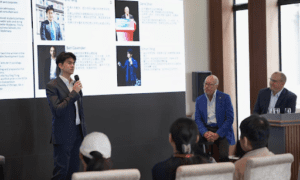In a time of escalating economic demands, growing inequality, and shifting public expectations, the imperative for governments to modernise their tax systems has never been greater. At the intersection of fiscal policy and artificial intelligence stands a new generation of thinkers, and among them, one voice is drawing international recognition for its clarity, ethical grounding, and practical solutions. Eseoghene Kokogho, a researcher whose work is reshaping how nations think about tax collection and citizen accountability, has proposed a transformative model that is capturing the attention of both American and British policymakers alike.
Her groundbreaking study, The Future of Tax Technology in the United States: A Conceptual Framework for AI-Driven Tax Transformation, lays out a compelling roadmap for governments struggling to close compliance gaps while improving efficiency, transparency, and equity. Though the research was initially developed with the United States in focus, the resonance with the United Kingdom’s own fiscal and administrative challenges is undeniable. Kokogho’s framework is increasingly viewed not only as a call to action but as a blueprint that could help usher in the next era of tax policy reform across advanced economies.
Speaking recently at a forum on public sector digitisation, Eseoghene noted, “The problem isn’t lack of political will. It’s that governments are often working with 20th-century tools to solve 21st-century problems. What we need is not just a technological upgrade, but a mindset shift. The tax system is the moral spine of a nation. It funds the roads we drive on, the schools we send our children to, and the healthcare that keeps our communities alive. If it fails, democracy frays.”
The UK’s tax authority, HM Revenue and Customs (HMRC), faces mounting pressure to resolve longstanding structural inefficiencies. In 2021, the UK’s tax gap stood at a troubling £35.8 billion approximately five percent of the country’s total tax liabilities. Of that, nearly £9 billion was lost to VAT noncompliance alone, and small business errors accounted for another £5.5 billion. These figures are not just accounting irregularities. They represent lost opportunities to fund public services, missed chances to build public trust, and widening rifts between the state and the citizenry.

Eseoghene’s framework does not offer a simplistic fix. Rather, it charts a step-by-step vision built on four key technologies—machine learning, robotic process automation (RPA), natural language processing (NLP), and blockchain woven together into a scalable model that reimagines how tax agencies can operate in a digitally fluid economy.
At the core of the proposal is machine learning. Using sophisticated pattern recognition, historical data, and real-time analytics, this technology can identify high-risk behaviours and flag noncompliant filings with unprecedented precision. In jurisdictions like the UK, where a growing gig economy, digital marketplaces, and small-scale self-employment complicate enforcement, predictive audit selection could drastically increase compliance without placing additional burden on honest taxpayers.
“The problem isn’t just that some people evade taxes,” Eseoghene explained. “It’s that the system lacks the vision to identify where the evasion is likely to occur. With machine learning, we can finally start acting proactively instead of reactively.”
Currently, both the IRS and HMRC are criticised for disproportionately targeting low-income earners, largely because their filings are easier to audit. Eseoghene’s framework argues that a smarter approach—one powered by AI—can reverse that trend by focusing attention where it matters most: on high-value evasions that distort the public finance system.
Equally transformative is her embrace of natural language processing. Each year, tax authorities around the world field millions of queries from confused, frustrated, and often overwhelmed taxpayers. The UK is no exception. During peak filing seasons, HMRC’s call centres are inundated, leading to long wait times, miscommunication, and missed deadlines. Eseoghene proposes an elegant solution: an AI-powered virtual assistant capable of conversing in multiple languages, breaking down complex tax jargon, and guiding users through filing steps in real-time.
“When we create systems that only a specialist can navigate,” she noted, “we alienate the very people we’re supposed to empower. NLP bridges the gap between policy and the public.”
This emphasis on inclusivity is central to her model. As the UK continues to expand its “Making Tax Digital” initiative, accessibility remains a key concern. Thousands of older individuals, non-native English speakers, and first-time entrepreneurs struggle to use online systems designed with little attention to user experience. Eseoghene’s vision of intelligent, citizen-facing tax technology could ensure no one is left behind in the digital transition.
Another standout in her proposal is robotic process automation. While AI handles the nuance of analysis and interaction, RPA automates the routine—validating forms, verifying documents, sending reminders, and issuing acknowledgements. For tax administrators facing shrinking budgets and escalating workloads, the ability to process millions of interactions efficiently without adding to staff pressure is critical.
“Automation doesn’t replace the human touch,” Eseoghene insisted. “It makes it possible. When systems handle the repetitive tasks, people are freed up to do the jobs that require empathy, judgment, and contextual thinking.”
It is her recommendation for blockchain, however, that positions her work as particularly forward-thinking. By introducing immutable ledgers into tax workflows, governments can provide tamper-proof records of transactions, audit trails, and refund activity. This technology, she argues, could not only reduce fraud but also create a more transparent relationship between citizens and tax authorities. In a time when public trust in government institutions is waning, this feature alone could redefine accountability.
In the UK, where invoice fraud and VAT carousel schemes continue to siphon billions of pounds, such a system could prove transformative. “Trust isn’t just built on enforcement,” Kokogho explained. “It’s built on transparency. Blockchain gives us that transparency in a way that’s secure, decentralised, and scalable.”
Perhaps most intriguingly, her framework incorporates simulation-based policymaking. Tax agencies could use AI models to forecast the impact of proposed reforms before they’re enacted—assessing, for example, how a new green energy credit might affect different income brackets or how a business tax hike could shift investment trends across regions.
For the UK Treasury, this capacity could offer a powerful tool in navigating the often politically fraught space of tax policy, providing data-driven clarity and helping avoid unintended consequences. “We don’t have to legislate in the dark,” Eseoghene pointed out. “We have the tools to run the simulations, test the variables, and measure the outcomes before anyone is impacted. We just need to start using them.”
However, her model is not uncritical of AI’s limitations. She acknowledges the risks of bias embedded in historical datasets and the danger of black-box decision-making. To guard against this, she calls for strong algorithmic transparency laws, independent audits, and robust appeals processes. These suggestions mirror the ethical guardrails proposed in the UK’s National AI Strategy and reflect her dual commitment to innovation and justice.
“Efficiency without fairness is not progress,” she said. “Technology must amplify equity, not undermine it.”
Her insights also extend to the workforce implications of digital transformation. Rather than advocating for mass automation and layoffs, she emphasises retooling public servants, arming them with new skills, and elevating their roles in a more complex digital tax ecosystem. This people-first approach contrasts sharply with the technocratic narratives often dominating the discourse.
“Our goal isn’t fewer public officers,” she said. “It’s better-equipped officers. Professionals who can interpret, contextualise, and oversee the AI tools that support them.”
Kokogho’s framework has gained traction beyond academia. It has been cited in policy workshops hosted by leading think tanks, referenced in fiscal reform proposals in Canada and India, and reviewed by HMRC officials as part of future-proofing deliberations. She is also being approached for consultancy and advisory roles in Europe and West Africa, where digital tax systems are still in their infancy.
For the UK, her ideas come at a moment of great need and great opportunity. The tax gap is growing. Administrative costs are rising. Public satisfaction with tax services is falling. And as the global economy evolves towards digital platforms, intangible goods, and decentralised finance, tax authorities must rethink everything from how revenue is assessed to how compliance is encouraged.
Implementing Kokogho’s framework could offer the UK a first-mover advantage in global tax innovation. It could deliver fairer enforcement, more intelligent policy design, stronger digital inclusion, and a foundation of trust at a time when citizens desperately seek it.
As she remarked in a recent interview, “We have two choices. We can digitise our inefficiencies, or we can redesign for intelligence, fairness, and trust. The future will reward the countries that choose the latter.”
Her vision is grounded in reality, driven by ethics, and powered by data. Whether HMRC and the Treasury will seize it remains to be seen, but one thing is clear: Eseoghene Kokogho is no longer just shaping the future of tax in the United States. Her work is becoming essential reading for anyone, anywhere, who wants to ensure that tax systems are not only smarter—but more human.































